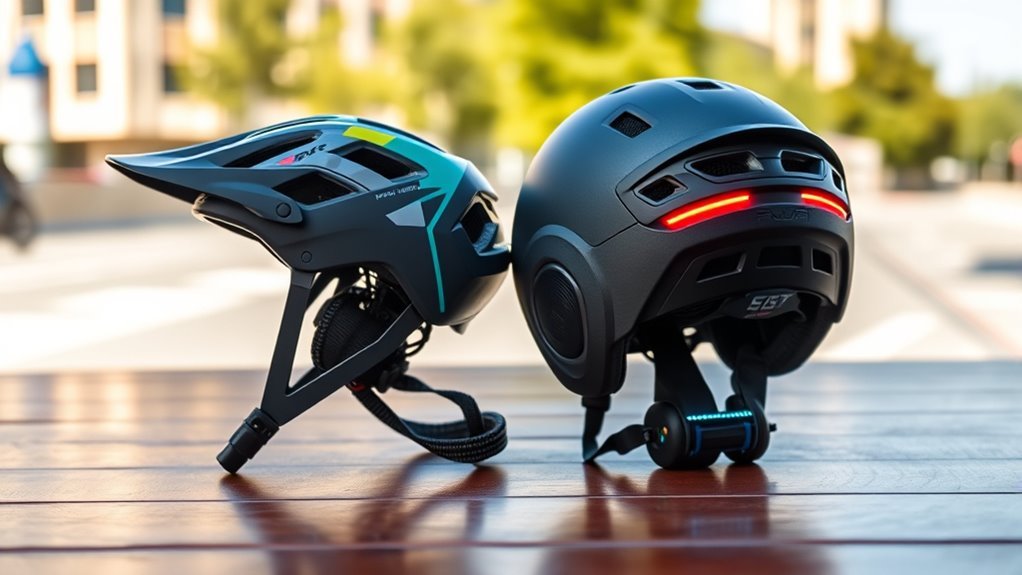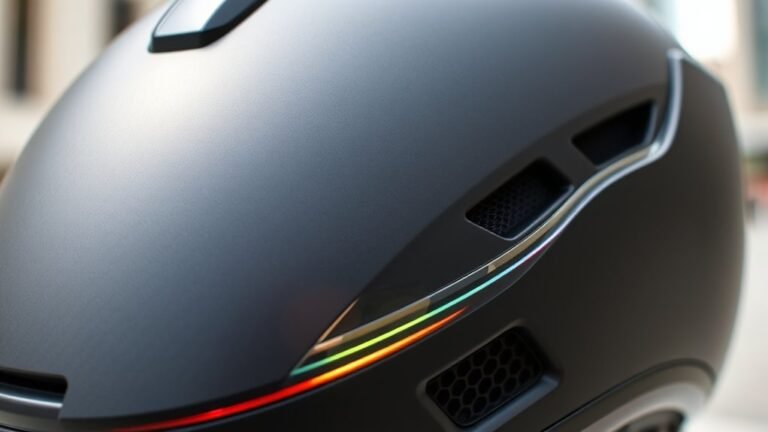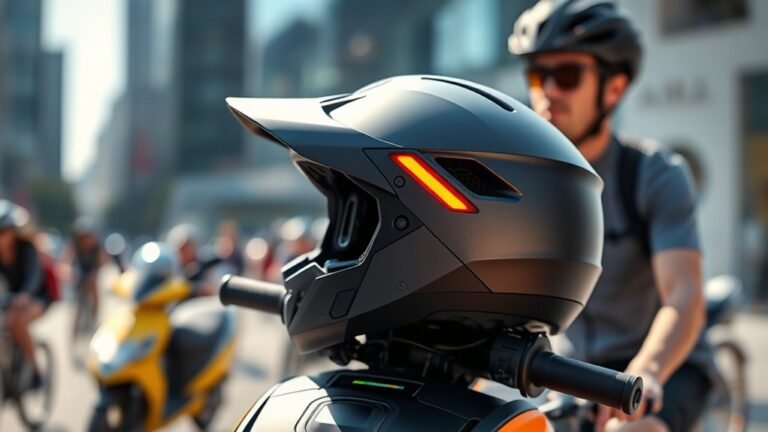Comparing Bicycle Vs E-Scooter Helmets
When comparing bicycle and e-scooter helmets, it’s crucial to contemplate safety standards, design, and impact protection. Bicycle helmets are typically lighter with more vents for airflow, while e-scooter helmets offer sturdier structures for stability during maneuvers. Material composition affects impact resistance, and fit customization is essential for both types. Visibility features, like reflective elements and LED lights, enhance safety. Each helmet serves a specific purpose, so understanding these differences can help you choose the right one for your ride.
Understanding Helmet Safety Standards
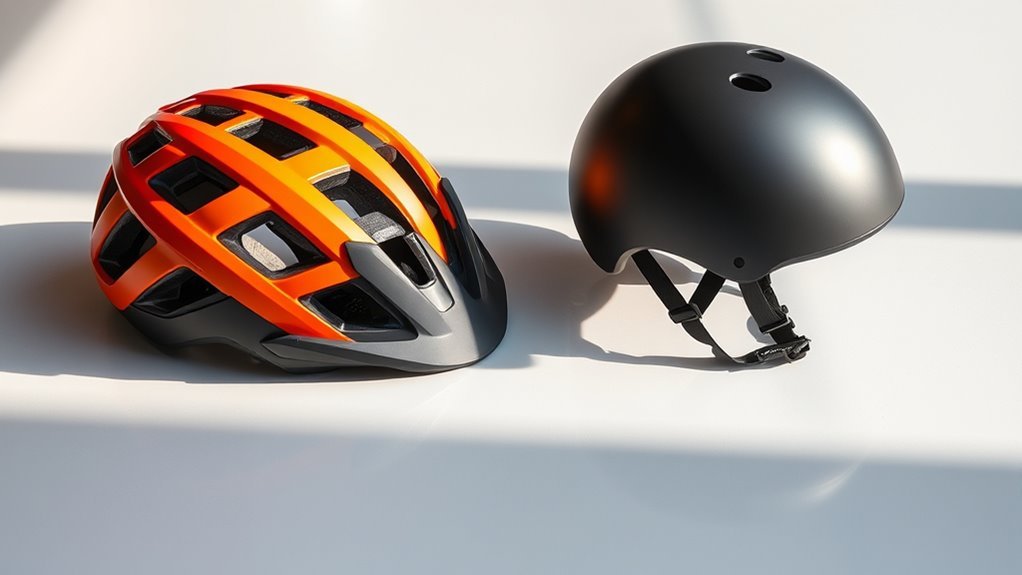
When you’re choosing between a bicycle or e-scooter helmet, it’s essential to understand the safety standards that govern them. Helmets are tested and certified according to specific helmet certifications, ensuring they meet certain impact resistance and safety requirements. For bicycles, look for certifications like CPSC (Consumer Product Safety Commission) or EN 1078. E-scooter helmets may also carry these certifications but often include additional standards like NTA 8776, tailored for higher speeds. Safety ratings reflect the effectiveness of these helmets in crash scenarios, so it’s vital to check these ratings before making a choice. Ultimately, understanding these safety standards empowers you to make an informed decision, keeping your freedom on the road both enjoyable and secure.
Design Differences Between Bicycle and E-Scooter Helmets
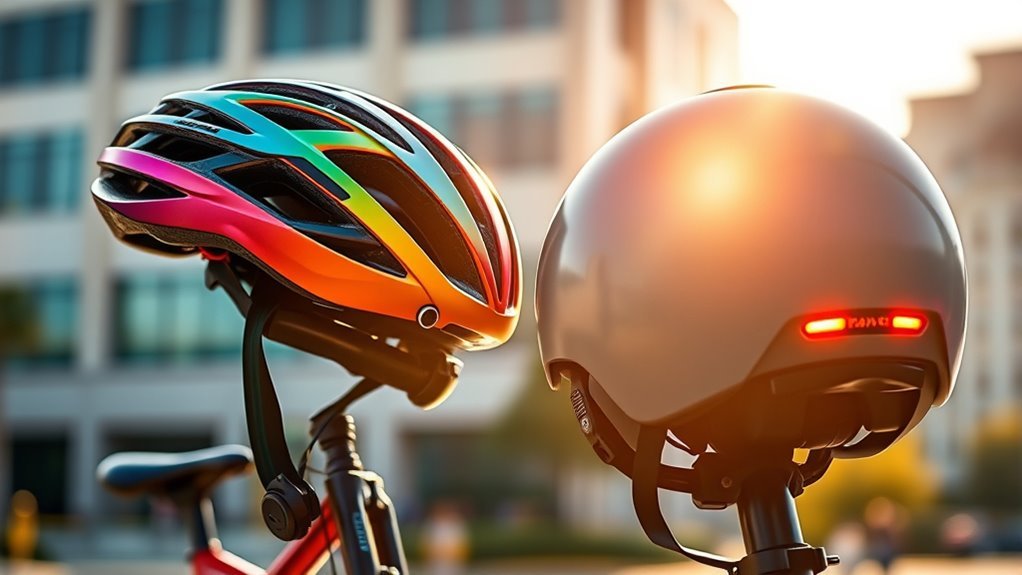
While both bicycle and e-scooter helmets serve the primary function of protecting your head, their designs reflect the unique needs of each activity. Bicycle helmets often feature an aerodynamic design, enhancing speed and airflow. Their shell shape is typically rounded, allowing for less wind resistance. In contrast, e-scooter helmets usually have a more robust structure, focusing on stability during sudden stops or turns.
Here’s a quick comparison to illustrate the differences:
| Feature | Bicycle Helmets | E-Scooter Helmets |
|---|---|---|
| Aerodynamic Design | Yes | Limited |
| Shell Shape | Rounded | More angular |
| Ventilation | More vents | Fewer vents |
| Weight | Generally lighter | Heavier for stability |
Understanding these design differences can help you choose the right helmet for your adventures.
Impact Protection and Materials Used
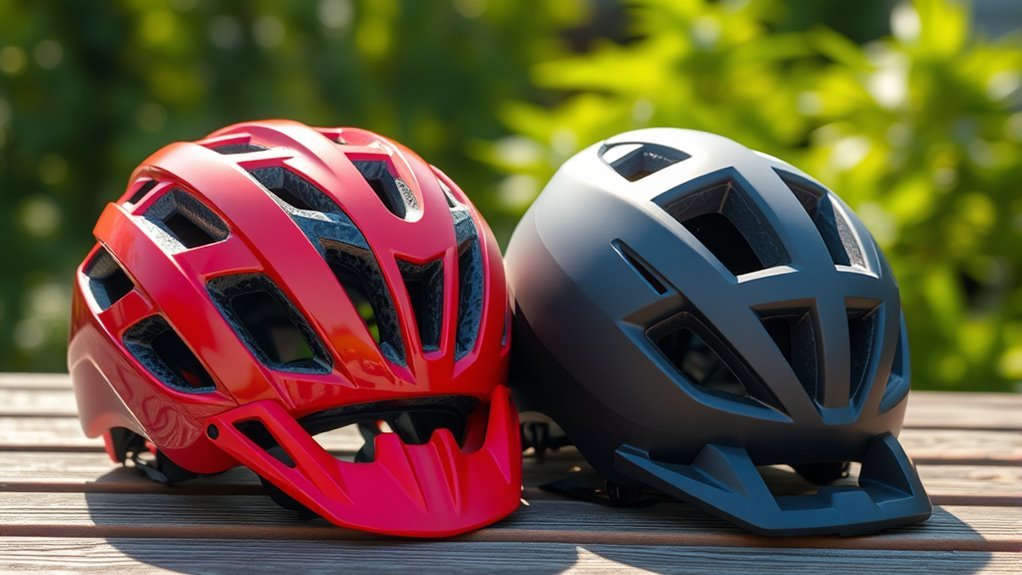
The differences in design between bicycle and e-scooter helmets also extend to their impact protection capabilities and the materials used in their construction. Bicycle helmets typically feature expanded polystyrene foam, known for its excellent impact resistance and energy absorption during crashes. This material guarantees that the helmet can withstand the rigors of cycling. On the other hand, e-scooter helmets often utilize a combination of materials, including polycarbonate shells and EPS foam, which enhance material durability while providing sufficient protection for lower-speed falls. While both types prioritize safety, the specific materials influence how effectively they can handle impacts, making it vital for you to choose a helmet that aligns with your riding style and the associated risks.
Ventilation and Comfort Features
When choosing between bicycle and e-scooter helmets, you’ll notice significant differences in airflow design that affect comfort during rides. Padding and fit are also essential factors that determine how well each helmet accommodates your head shape and keeps you cool. Understanding these ventilation and comfort features can help you make a more informed decision for your riding needs.
Airflow Design Differences
Although both bicycle and e-scooter helmets prioritize safety, their airflow designs reflect different considerations for ventilation and comfort.
Bicycle helmets often feature more pronounced airflow channels that enhance ventilation efficiency during high-speed rides. In contrast, e-scooter helmets may incorporate a more streamlined design, focusing on urban commutes at lower speeds. Here’s how they differ:
- Bicycle helmets: larger vents for maximum airflow.
- E-scooter helmets: smaller, strategically placed vents to maintain a sleek profile.
- Bicycle helmets: lightweight materials promote breathability.
- E-scooter helmets: added insulation for cooler weather comfort.
Understanding these airflow design differences can help you choose the right helmet for your riding style, ensuring you enjoy freedom while staying comfortable and safe on your journeys.
Padding and Fit
While both bicycle and e-scooter helmets prioritize safety, their padding and fit greatly influence overall comfort and usability. The padding thickness can vary greatly between the two, affecting how snugly the helmet sits and how much shock absorption it provides. Bicycle helmets often feature thicker padding for long rides, while e-scooter helmets may have lighter padding for a more streamlined experience.
Fit customization is also essential; many helmets offer adjustable systems to guarantee a secure fit for different head shapes. A well-fitted helmet enhances comfort and minimizes distractions, allowing you to enjoy your ride fully. Ultimately, when choosing between the two, consider how the padding and fit will contribute to your freedom on the road.
Visibility and Reflective Elements
When choosing a helmet, color options play an essential role in your visibility on the road. Reflective strips can greatly enhance your safety by making you more noticeable to drivers, especially in low-light conditions. By comparing the visibility features of bicycle and e-scooter helmets, you’ll better understand which option offers superior protection in varying environments.
Helmet Color Options
Choosing the right helmet color is crucial for enhancing visibility and safety. In a world where freedom on two wheels is paramount, you want to stand out. Helmet color trends are evolving, and vibrant helmet designs can make a significant difference. Here are some options to evaluate:
- Bright Neon Colors: Easily catch the eye of drivers and pedestrians.
- Fluorescent Shades: These hues pop during the day and glow under streetlights.
- Bold Patterns: Unique designs not only enhance visibility but also express your style.
- Classic Whites and Yellows: Timeless choices that maintain a high visibility standard.
Selecting a helmet color that reflects your personality while prioritizing safety can empower your ride, ensuring you’re seen on every adventure.
Reflective Strips Importance
Reflective strips play an essential role in enhancing visibility, especially during low-light conditions. When you ride a bicycle or use an e-scooter, reflective safety elements are vital for ensuring other road users can see you. These strips reflect light from car headlights, making you more noticeable at night. Without them, your risk of accidents increases considerably, as many drivers may not spot you until it’s too late.
Incorporating reflective strips into your helmet design not only improves nighttime visibility but also boosts your overall safety. They serve as a simple yet effective way to enhance your presence on the road. So, whether you’re cruising through city streets or enjoying a night ride, reflective safety is not just an accessory—it’s a necessity.
Visibility Features Comparison
How do the visibility features of bicycle and e-scooter helmets compare regarding safety? Both types of helmets aim to enhance your visibility on the road, but they differ in their approach. When choosing a helmet, consider these visibility enhancements and reflective accessories:
- Reflective strips: Often found on both helmet types, they improve visibility in low light.
- Bright colors: Many helmets feature vibrant colors, attracting attention from drivers.
- LED lights: Some e-scooter helmets come with integrated lights, increasing your presence at night.
- Removable visors: Certain bicycle helmets include visors that can help block sun glare, improving your overall visibility.
Understanding these features can help you make a safer choice for your rides, ensuring you stand out while enjoying your freedom.
Weight and Portability Considerations
While both bicycle and e-scooter helmets serve the essential purpose of protecting your head, their weight and portability can greatly influence your choice. When you consider weight distribution, bicycle helmets tend to be bulkier, affecting comfort during longer rides. On the flip side, e-scooter helmets are often lighter and designed for quick trips, making them easier to carry. Portability factors are vital, especially if you plan to store your helmet in a bag or carry it on public transport. A compact design can enhance your freedom, allowing for spontaneous rides without the hassle of bulk. Ultimately, weighing these aspects will help you choose a helmet that complements your lifestyle and riding habits.
Fit and Adjustment Mechanisms
Choosing the right helmet involves more than just considering weight and portability; fit and adjustment mechanisms play a significant role in ensuring safety and comfort. Understanding the various fit types and their adjustment features can enhance your riding experience.
- Dial Systems: These allow for easy tightening or loosening, ensuring a snug fit.
- Strap Adjustments: Properly positioned straps enhance stability and security, essential for high-speed rides.
- Padding Options: Removable padding can adjust fit and comfort based on personal preference.
- Size Variability: Helmets often come in multiple sizes, accommodating different head shapes.
Pricing and Budget Options
When it comes to selecting a helmet for biking or e-scootering, pricing can greatly influence your decision. You’ll want to weigh your budget considerations against the safety and features offered by different models. Fortunately, there are a range of affordable options available. Basic helmets often start at lower price points, making them accessible for casual riders. However, investing a bit more can provide enhanced protection and comfort features. Look for helmets that meet safety standards while still fitting within your financial plan. Remember, prioritizing quality over price can guarantee you get the best value for your money. Ultimately, finding a balance between affordability and safety will help you enjoy your ride more freely.
Choosing the Right Helmet for Your Needs
Finding a helmet that suits your specific needs is key to guaranteeing safety and comfort, especially after evaluating your budget. There are various helmet types available, each catering to different user preferences. Here’s what to reflect on:
- Weight: Lighter helmets offer more comfort during long rides.
- Ventilation: Good airflow can keep you cool, especially in warm weather.
- Fit: Assure a snug fit for maximum protection; adjustable straps are a plus.
- Style: Choose a design that reflects your personality while meeting safety standards.
Frequently Asked Questions
Can I Use a Bicycle Helmet for E-Scooter Riding?
Yes, you can use a bicycle helmet for e-scooter riding, but it’s essential to guarantee it meets safety standards. Picture yourself gliding through the streets, wind in your hair, but your helmet’s fit must be snug to protect you effectively. While both helmets serve similar purposes, e-scooter helmets often emphasize different impact zones. Always prioritize your safety and comfort, choosing a helmet that feels secure, allowing you to enjoy your ride with freedom.
Do E-Scooter Helmets Come With Built-In Lights?
Yes, many e-scooter helmets come with built-in lights, enhancing your safety and visibility features while riding. These lights can greatly improve your awareness in low-light conditions, ensuring you’re seen by others. When choosing a helmet, consider those with integrated lights as they offer an added layer of protection. You’ll want to prioritize helmet safety, so investing in a model with these features can help you ride freely and confidently, day or night.
Are There Specific Age Requirements for Helmet Use?
Yes, there are specific age requirements for helmet use, which vary by location. Many places have helmet laws mandating that children under a certain age, often 16 or 18, must wear helmets while riding bicycles or e-scooters. These age restrictions aim to enhance safety, especially for younger riders who may be at greater risk. It’s important to check your local regulations to guarantee compliance and promote safe riding practices.
How Often Should I Replace My Helmet?
You should replace your helmet every three to five years, even if it looks fine. Imagine taking a tumble; the impact can compromise the foam inside, reducing its protective capabilities. Over time, materials degrade, diminishing the helmet’s lifespan. If you notice any cracks or significant wear, it’s time for a new one. Prioritizing safety means embracing freedom without the worry of inadequate protection—so don’t skimp on that essential piece of gear!
Do I Need a Helmet for Short E-Scooter Trips?
Yes, you should wear a helmet for short e-scooter trips. Safety is paramount, even on brief rides. E-scooter regulations often require helmets, ensuring you’re legally compliant and protected. Consider that accidents can happen quickly, and a helmet provides essential protection. While you might feel confident, it’s better to prioritize your safety. Embracing freedom doesn’t mean ignoring potential risks; a helmet can enhance your riding experience without compromising your sense of adventure.
